At ABP, our approach to wood production goes beyond the trees. We're committed to rigorous health and safety standards, responsible environmental management and proactive fire prevention and control.
Health and safety
At ABP, we’re committed to our value, ‘Make safety our mindset’.
Our comprehensive policies cover everything from vehicle and chemical use to fatigue management.
Through strong leadership and ongoing improvement, we promote safe behaviours and address any potential risks.
This commitment extends to our contractors, as well. So all our workers return home safely.
Health and safety programs include:
Light vehicle driver safety training program
Recognising vehicle operation as a primary safety risk, ABP developed a light vehicle driver safety training video.
Released in late 2019, this well-received video is now integral to our online induction, ensuring all employees and contractors adhere to ABP’s safety standards.
WakeUp
Here at ABP, we care about all facets of our employees’ health and wellness.
And with our WakeUp program, we take a holistic approach to ensure all our staff are feeling their best.



Environmental management
Environmental programs
ABP’s environmental programs focus on habitat restoration, revegetation and species protection.
Key initiatives include planting native habitats, installing nest boxes, restoring wetlands and controlling pests.
Each initiative is supported by local groups and conservation organisations.
Koala program
ABP is committed to zero harm for koalas in our plantations. To meet that commitment, we use expert spotters in koala zones during harvest to ensure we leave habitat trees standing.
We also collaborate with the Victorian Government under Koala Management Plans to ensure safe and sustainable forestry operations.
Cultural heritage
ABP acknowledges the traditional custodians of the land on which it operates and is committed to protecting Indigenous heritage sites within the estate.
That includes all historic and archaeological areas.
We welcome input from Indigenous and community groups to manage culturally significant locations effectively.
Learn more about our environmental programs on our blog.
Fire management
ABP takes wildfire risk seriously – and has implemented extensive fire prevention measures as a result.
Our trained staff and contractors use strategically placed equipment and vehicles and maintain water points, fire breaks and weed control to reduce risk.
During high-risk periods, we follow all regulatory fire requirements and guidelines, halt operations and may impose harvest and vehicle movement bans to ensure the safety of our staff.
